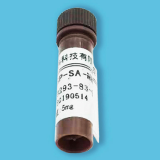- Category :
Other Chemicals/Others
- CAS NO : 211106-69-3
- EC NO :
- Molecular Formula :
- Main Specifications : White Powder
- Synonyms : NSP-AS;
Package: 1g/bottle
Uses : Chemiluminescence reagent
Product description:
Acridine salt NSP-SA is a member of the luminescent reagent Acridine class compounds. As an effective chemiluminescence marker, it has obvious advantages, such as rapid and stable luminescence, high sensitivity and signal-to-noise ratio, and little external interference. At the same time, the requirements for various experimental operations are simple, and the obtained results have high accuracy, which plays an indispensable role in the automation of immune analysis. Below is a specific introduction to it, which can also be used separately from other reagents in the future.
1、 Composition and properties
The luminescent reagent acridine salt NSP-SA has a CAS of 211106-69-3 and a molecular weight of 584.66. It appears as a yellow powder with high solubility and strong stability in water. Its diluted solution exhibits purple or green fluorescence. If further diluted, it will become free acridine due to salt hydrolysis, exhibiting purple fluorescence. The acridine salt NSP-SA has a wide range of uses and can be used as a photocatalyst and in the preparation of dyes.
2、 Purpose
The luminescent reagent acridine salt NSP-SA can be used in biomedical research, such as detecting markers such as proteins, nucleic acids, antigens, and antibodies. By observing the fluorescence signal in the sample using acridine salt, it is possible to determine the presence of target molecules in the sample. In addition, pyridine salt NSP-SA can also be used in fields such as photocatalysts and dye preparation.
3、 Usage method
The method of using acridine salt NSP-SA is relatively simple. Firstly, the reagent needs to be mixed with fluorescent dyes to form a fluorescent labeled complex. Then, the complex is added to the sample to be tested, such as a protein or nucleic acid solution. Finally, the fluorescence signal in the sample can be observed using a fluorescence microscope. Pay attention to avoiding reagent contamination and light intensity issues during use.
As an advantageous supplier of luminescent reagents, Desheng produces six types of acridine series products, which are available for customers to choose from comprehensively. At the same time, its purity can reach up to 98%, and its luminescence is sensitive and fast, which is conducive to various experimental research uses. If you have any interest, please click on the website to contact us!
 CN ChemNet > Gold Suppliers > Hubei new DE sheng material science and technology co., LTD. >
CN ChemNet > Gold Suppliers > Hubei new DE sheng material science and technology co., LTD. > 